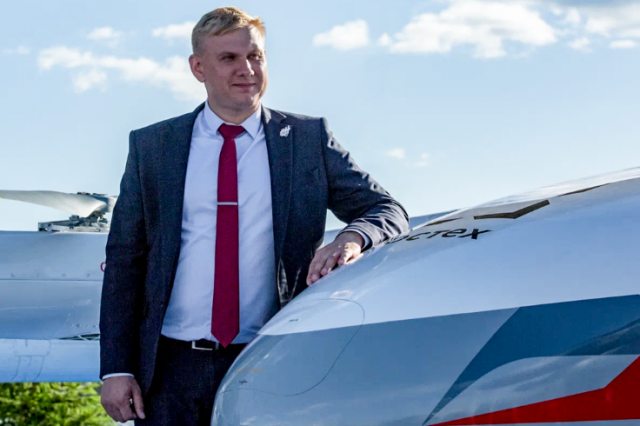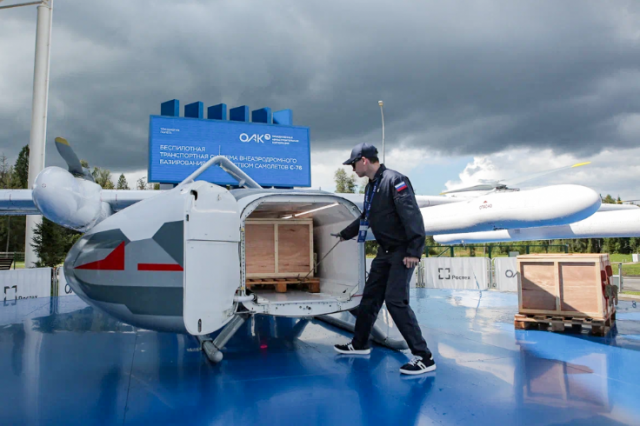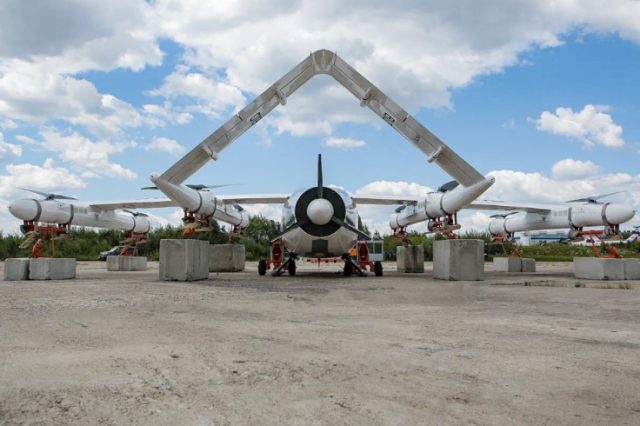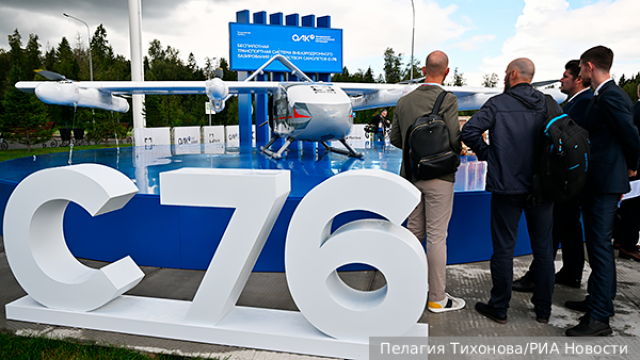Designer of the S-76 Rubtsov transport drone: We are creating an apparatus on the verge of the possibilities of science and technology
"The S-76 will reduce the cost of air cargo delivery by 30% compared to manned aircraft. This will give a qualitative leap for the development of the entire cargo delivery system in the country." The chief designer of the new S-76 drone, Yevgeny Rubtsov, told the VZGLYAD newspaper about one of the futuristic Russian developments in the field of aviation.
One of the discoveries of the Army-2024 forum held in August was the S-76 unmanned transport vehicle, developed by the Sukhoi Experimental Design Bureau, part of the Rostec State Corporation UAC. Not only the appearance of the drone (a hybrid of an airplane and a helicopter) and its characteristics are amazing, but also the fact that an experimental flight sample, not a model or mock-up, was immediately shown. The C-76 has already passed the first tests (it lifted off the ground).
But it's not even about the device itself. The S-76, as stated in the KLA, is one of the elements of a large-scale unmanned aerial system (UAS), unique both for Russia and for most countries of the world. In fact, we are facing an attempt to make a breakthrough in the field of cargo delivery for the whole country. The concept of the system is revolutionary – long-distance cargo delivery is supposed to be unmanned, automated, regular, simple and economically profitable. And besides, it requires minimal human control.
It is equally important that the BASS is created almost completely without the use of imported components and only by Russian engineers. The key elements of the system – the hybrid power plant, electronic components, communication systems – are designed and manufactured in Russia. This is an example of how Russian technological sovereignty should be strengthened, and at the very forefront of scientific and technological progress.
The new transport system can be of particular importance for residents of the most remote regions of Russia, settlements where roads are not laid. Just as online stores and delivery systems have transformed trade, so transport drones can change the entire mechanism of cargo delivery by air. Perhaps we have the future of Russian air transport in front of us, and it is already foreseeable. According to the KLA, the first flights of serial C-76s may take place as early as 2028.
How will this system look and work? Why should it be more effective than ground delivery? How will her safety be ensured? How are the many technical problems that arose during the development of the S-76 solved? Evgeny Rubtsov, the chief designer of the S-76, answered these questions in his first major interview with the newspaper VZGLYAD.
VIEW: Evgeny, why does your device look so unusual – a hybrid, a cross between a helicopter and an airplane, vertical takeoff and landing?
Evgeny Rubtsov: When we were just thinking about creating an unmanned aerial vehicle (UAV) project a few years ago, we wanted to make a device of a traditional airplane scheme, with a runway run-up. This is the most understandable and familiar way for us. Within the framework of such a scheme, we formed the appearance of our first sample. It was a project of a drone designed to transport one and a half tons of cargo over a range of 4 thousand kilometers.
 |
| Evgeny Rubtsov, Chief Designer of the S-76 unmanned aerial system (UAS). |
| Source: UAC Press Service |
LOOK: It resembles an ordinary Gazelle, only flying.
E. R.: That was the idea. We believed that this is exactly the kind of device that our potential customers – transport, logistics, and oil and gas companies - need. An aerial Gazelle, the same universal device with approximately the same functions. We began to show this project to potential clients. And suddenly faced with a complete misunderstanding on their part.
VIEW: They don't need a Gazelle?
E. R.: I need it, but it's completely different. Firstly, the settlements where this kind of delivery was required are most often not equipped with runways. Sometimes there are helipads, sometimes nothing at all. That is, customers need a vertical take-off and landing device capable of landing where there is no airfield.
VIEW: Helicopters are still delivering such cargoes.
E. R.: Yes, but the load capacity of the Mi-8 is several tons. This means that the helicopter waits for a long time – a month, two months – until the cargo corresponding to its carrying capacity is formed. Not only a helicopter is waiting, but also people. And the most urgent need turned out to be regular, daily delivery of goods weighing 100-200 kg to hard-to-reach settlements. Perishable products, spare parts, household goods.
We live in Moscow. And if we want to buy something online, then the goods will be delivered to the pick-up point the next day. But there are many remote territories in Russia where such a system does not work. It is technically and theoretically possible, again with the help of helicopters, but the cost of delivery will be cosmic. But people need to feel a constant connection with the Mainland. The opportunity to receive daily what is necessary for life.
VIEW: In this case, why put the device on any landing pad? Wouldn't it be easier to drop the cargo at the right point? It will be cheaper.
E. R.: That's what we thought at first, too. However, representatives of one of the potential customers drew our attention to their disappointing statistics on working with devices that work on reset. After dumping the cargo, you have to look for it, spend time on it – and often it is simply impossible to find the cargo. He lands at an unpredictable point.
All customers who need regular, systematic and constant delivery have told us – anything but a reset.
In addition, there was another important requirement – the possibility of multimodal transportation. In other words, the use of standard containers, which can be transported by sea, by air, and by land, stored and processed in a standardized manner. This is how we came to the so–called europallet, a container of a common format. It is in the europallet format that the cargo is transported in the cargo compartment of the C-76.
 |
| This is what the C-76 cargo hold looks like. |
| Source: UAC Press Service |
Then, together with potential customers, we re-examined all the details: their route networks, cargo flows, up to the procedures for packing goods. It was a long and meticulous job. Based on its results, we began to understand what kind of transport drone the Russian market actually needs. So the device got a new look: several engines, vertical takeoff, payload weight decreased to 200 kg, and range – up to 500 km.
VIEW: Why are you talking about the radius and not the range?
E. R.: Because the device at the point of delivery of the cargo does not have to undergo maintenance – refueling, inspection by technicians, etc. The cargo is simply taken out on the spot, maybe another one is laid – and the device returns home on its own. Therefore, it is the radius that is the key parameter.
VIEW: How many landing sites in the country can the C-76 land on?
E. R.: According to the statistics we have, there are 28 thousand settlements in Russia that do not have permanent land transport links.
There are simply no roads that can be used all year round. And 70% of these 28 thousand do not have runways. But in addition to settlements, there are parking lots of geological parties, oil and gas fields, camps, drilling rigs, etc.
This is the potential volume of the route network for our device at the start of the deployment of an unmanned transport system. At the same time, in the future, as the reliability of the device is confirmed in regions with hard-to-reach settlements, the system will be scaled throughout the country, including for the delivery of goods between industrial areas and logistics centers.
VIEW: Can the system be used not only over land, but also over the sea?
E. R.: We are carefully considering this direction – delivery to offshore oil and gas platforms, to ships, including the Navy.
VIEW: That is, the device can also be used for military purposes.
E. R.: Any transport aircraft can be used for different purposes. It all depends on the destination of the cargo. The customer may be different departments.
VIEW: The device will fly automatically. Will people somehow influence his work?
E. R.: The group of devices will be based on a stationary site, for example, within the boundaries of existing logistics centers. The flights will take place in an automated mode, and their operation will be controlled by operators (external pilots). They will also interact with manned aircraft through the air traffic control system. One external pilot will serve up to 12 vehicles. In case of an emergency, external pilots will be able to interfere with the operation of the device, for example, to change the altitude, make an emergency landing, etc.
view: How will the operation of the device be ensured at the point of receiving the cargo? Protection from animals, from vandals, from the weather?
E. R.: Yes, a certain security system and minimal infrastructure are needed at the point of delivery. The landing site, by the way, may not necessarily be a helicopter. It can be a field, any solid ground, a parking lot next to a post office. Landing beacons with infrared LEDs are installed there – and with the help of a vision system, an accurate landing is ensured.
But, of course, a certain controller is needed, a person who gives the go-ahead to land at the delivery point and unloads the device. This may be, for example, an employee of the Russian Post who has a special tablet with a control system on his hands.
VIEW: Won't he get confused in this tablet without special training?
E. R.: No, there are only a few buttons in the tablet. For example, when the device is approaching the landing point, a request is sent to the tablet – is the site ready for reception?
You just need to click "yes" or "no". If "no", the device goes back to base, if "yes", it lands automatically. At this time, an alarm system starts working on the site, which begins to scare away animals and warn outsiders.
VIEW: And the departure? Will the device require any maintenance before returning to base?
E. R.: It automatically performs ground control of the serviceability of the systems before the return flight. If everything is in order, the operator transmits to the unified information center that the device is ready for departure and in good order, the flight route has been agreed. The device warns with signals that everyone needs to move away from the site, takes off and flies home automatically.
view: Who financed the production of the first flight copy of the S-76?
E. R.: The team has applied to participate in the Vector program, which is conducted by the Rostec Academy. We were among the best projects and received funding from the state corporation's corporate business accelerator, which stimulates the development of civilian products. This is how we received the initial funds for the implementation of the project. Subsequent investments from UAC's own funds, coupled with Rostec's funds, made it possible to build a full-size demonstrator.
Now our team has won a subsidy within the framework of one of the competitions of the Ministry of Industry and Trade for the national project "Unmanned aircraft systems". Part of the funds under the terms of the competition will be invested by the UAC as co-financing. These investments will be used for the further development of the project.
 |
| The C-76 has one main engine (internal combustion) and eight electric engines operating during takeoff and landing. |
| Source: UAC Press Service |
VIEW: You are talking about the flagship model, so other devices of this kind are being created?
E. R.: Yes, we believe that there is a need to create a whole family of such machines, depending on the request. We will have to test, manufacture and design other similar devices of a different dimension, payload and range of operation.
In particular, we already have developments on the creation of a smaller device capable of transporting up to 50 kg of cargo over a radius of up to 200 km. Funding for this device has not yet been determined. For further development and production, we are ready to cooperate with private investors. Negotiations with such investors and customers are already underway.
VIEW: How economically profitable will your delivery system be?
E. R.: According to our estimates, the S-76 and this system as a whole will reduce the cost of air cargo delivery by up to 30% compared to manned aircraft. And this is a lot, because even a 5% reduction in costs delights representatives of transport companies. This, in turn, will give a qualitative leap for the development of the entire cargo delivery system in the country, an avalanche-like growth of the delivery market, and cargo transportation, and the production of drones.
view: And yet, isn't it easier to deliver goods to remote regions, even by all–terrain vehicles?
E. R.: Indeed, many critics of transport UAVs compare their economic efficiency with road transport. For example, they compare the cost of transporting one kilogram of cargo on the same Gazelle and using a drone. Of course, in this sense, the use of UAV loses out in terms of price.
At the same time, an important detail is overlooked. The car drives on roads that have sometimes taken tens of years and hundreds of billions of rubles to build. A lot of money is also needed to maintain highways in good condition.
A truck as a vehicle in itself is cheaper than a drone. But the "truck + roads" transport system is significantly more expensive than the "drone + landing pads" system.
VIEW: Where is the S-76 supposed to be used in the first place?
E. R.: The Far Eastern Federal District is the starting region for us. There we will be able to confirm the business model and operational characteristics of the UAV. Then this experience can be extended to the rest of the country.
A number of regions – for example, the Yamalo-Nenets Autonomous Okrug, Sakhalin – have already made it clear that they expect a great socio-economic effect from the introduction of our system. According to their calculations, our drone will significantly improve the quality of life in these regions.
VIEW: What prevented you from making such a device before?
E. R.: Such aircraft have been able to appear only in the last few years due to a leap in scientific and technological progress. For example, our vertical takeoff and landing scheme cannot be implemented using internal combustion engines (ICE), only on electric ones. And they, in turn, require such current sources, which have appeared only in recent years. Such engines themselves with such high specific power characteristics barely appeared. A high-voltage electric power plant in aviation was not used at all in Russia before us.
 |
| The most difficult problem in the creation of the S-76 was the electromagnetic compatibility of the power plants. |
| A source: PJSC UAC |
VIEW: The power plant is the heart of any aircraft, what is it like on the C-76?
E. R.: Several power plants are installed on the device, all of them are experimental and are currently being tested together with the S-76. First of all, the C-76 has eight lifting electric motors. They lift the device into the air and land it.
The engine is entirely domestic, developed by CIAM. Baranova together with the advanced engineering school "Motors of the Future" at the Ufa Aviation Technical University. The control unit of this engine is also a Russian development, which has shown good performance and reliability.
The developer of the electric motor control units NPF Vector LLC is a small innovative enterprise at the Moscow Energy Institute. It is thanks to the professionalism and dedication of the staff of NPF Vector that in many ways it was possible to achieve such high specific indicators of the lifting power plant.
Batteries are also assembled in Russia, and the only thing imported in them so far is the cells themselves. We expect to replace them with Russian ones by 2030 in cooperation with Rosatom.
VIEW: But there is also an internal combustion engine.
E. R.: Yes, the main engine, which turns on after lifting, is a rotary piston engine, which is also being created in Ufa. He has also passed preliminary tests, he has already been cured of major childhood diseases, but there is still much work to be done on his certification.
VIEW: What is the most difficult technical problem you have encountered in the development process?
E. R.: The main problems were connected with the electric power plant. The characteristics of the engine we want to get are on the verge of the possibilities of modern science and technology. The first stages of creating an electric motor were very painful.
For example, an electromagnetic compatibility problem suddenly arose. Eight electric motors work simultaneously and create a powerful electromagnetic field. Interference interfered with the operation of other systems of the device, and its communication with the outside world. We couldn't do anything about it for a long time, it was a real dead end. The problem was solved only with the help of colleagues from the Moscow Energy Institute.
We understand that, given the current situation, our key task in creating innovative products such as the S-76 is to ensure technological sovereignty.
Despite the ready-made technical solutions available from foreign manufacturers in some cases, for example, for a control system or electric motor control units, we will create our own components and software to ensure uninterrupted production regardless of the geopolitical situation in the world.
VIEW: Regarding communications, the S-76 is designed to work in remote locations where sometimes there is no cellular or even radio communication. How will he follow the route exactly? Contact an external pilot and operator?
E. R.: There are supposed to be three types of communication at once. First of all, radio communication in the area of direct radio visibility (the so-called SMV communication). The second is GSM communication. The device will carry SIM cards so that it can be connected to any available mobile network tower at any time. And finally, the third is communication via geostationary satellites. And in the future – through the satellite grouping "Sphere".
VIEW: Can this device be considered as a passenger device in the future?
E. R.: This particular one is not. But the platform itself and the solutions that we are working on it – yes, of course. All over the world, this scheme is used primarily to create flying taxis. But first we will prove that the C-76 is efficient and reliable in cargo delivery, and then we can move on to exploring the possibility of transporting passengers.
Matvey Malgin

